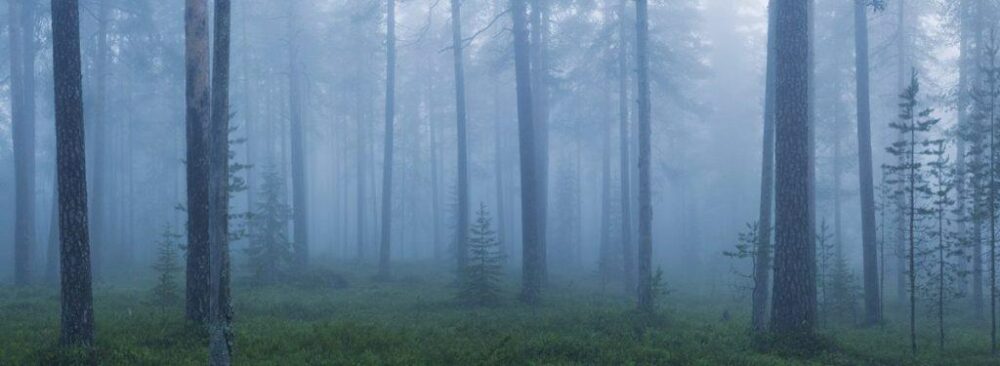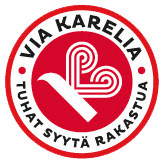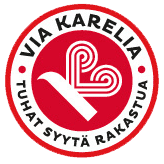
Patvinsuo National Park
Level: * * * (three bears)
Have you ever wandered on a large swamp? It’s an experience worth having. The size of the Patvinsuo swamp makes its horizon look like that of a vast lake with many islands. The landscape is decorated with vast expanses of swamp, their colours changing by the season, hills with spruces or pines, narrow bands of trees along the rivers and streams, and small ponds.
The Finns – at least the city dwellers – are said to be afraid of swamps. There’s no need to – swamps are not swallowing people as a habit. However, knowing you way around the marshy bits makes wandering around a swamp much easier. If you can see actual water, you won’t be able to cross the spot with dry feet.
For a swamp, Patvinsuo is an exceptionally safe place. Marked trails run through even the vastest expanses of swamp, and duckboards will take you across the wet stretches making the trails accessible with hiking boots or sneakers, apart from the spring, when the ground thaws and the paths may flood. There are camping grounds with designated sites for campfire, and as many as three bird watching towers.
Patvinsuo is Where Northern and Southern Nature Meet
North of Lake Koitere, with its hundreds of islands, on the borderlands of Ilomantsi and Lieksa, the Patvinsuo National Park is a place where the northern and southern characteristics of nature meet. This is particularly evident in swamp nature. The region has both raised bogs, typical of the south, and string bogs, more often met in the north. In its core, Patvinsuo is a northern type of swamp with bog ponds.
A raised bog is a swamp, where the middle part is higher than the edges. The middle part is very barren, because it gets water only when it rains. A northern swamp, on the other hand, is lower in the middle, which makes the surrounding melt waters and rain water run in with their minerals, constantly flushing the swamp.
These oligotrophic swamps grow hare’s-tail cottongrass, cloudberries and cranberries. The raised bogs, or kermi bogs, grow large sedge plants and deer grass. A delicious tip: at the time when both cloudberries and cranberries are ripening, most of the seasonal restrictions are no longer valid, and you’re free to wander and find the best berry-picking spots.
Small swamp areas along the hillsides add to the diversity of the swamp nature.
Pretty Sandy Beaches and Wilderness
The Patvinsuo National Park is not all about just swamps. The northern parts, along the shores of Suomunjärvi wilderness lake, open up a whole new world. White beaches, bright heaths with tall pines, long, sandy capes and many islands.
The Patvinsuo National Park is now uninhabited, but the area has a colourful history of human settlement.
Lake Suomunjärvi’s Kuikkaniemi cape was inhabited as early as in the 17th century. Today, a chimneyless hut, Savupirtti, stands empty on the cape point. It was built in late 19th century as a “kalasauna”, a base for fishing trips and handling the catch. Seine-fishing late in the autumn was a festivity for nearby villagers.
The Suomunjärvi forest warden’s estate was found in the 19th century. The current main building, Suomu Nature Information Hut is from 1953. On the grounds there’s a holy tree, “karsikkopuu”, where the family of forest wardens have carved their mementos. On the side of the pine tree, traces of commemorative carvings for the first forest warden’s sons’ deaths in 1875 and 1895 can be seen, among others.
During the war, the area was known for burning charcoal for cars using coal gas. Lake Koitere has been as source of limonite, tar has been burned on its shores, and the area has had many logging sites. After the war, the park and its vicinity had many farms inhabited by war veterans and their families, but they have all become deserted. A great many of them moved to Sweden in the 1960’s in search of a better life.
The Largest National Park in Southern Finland
The Patvinsuo National Park is the largest one in the southern part of Finland. The park has a vast network of hiking paths. There’s enough attractions for days, or why not a week, in the wilderness. If you don’t have a week to spare, there are three 3-5 km round trip paths: Mäntypolku (pine path), Lakkapolku (cloudberry path) and Kuusipolku (spruce path), each demonstrating a different type of nature. There’s also Suomun kierto, a 15 km round trip path.
In winter, Patvinsuo does not have ready made cross-country trails, but the flat, windblown stretches of swamp are perfect for independent ski touring in the winter or spring. The Suomuntie road leading to the Suomu Nature Information Hut’s parking area will be kept clean from snow from road 5202.
The campfire sites and lean-tos of the summer trails are useful in the winter, too. In early winter, wandering is allowed in those swamps too, where spring and summer are off-limits because of birds nesting. Please be aware that restrictions start to apply in the beginning of March.
Patvinsuo in a Nutshell:
Location: Lieksa and Ilomantsi, North Karelia
Area: 105 km2
Founded: 1982
Further info:
Driving Instructions:
Following signs, turn from Via Karelia (522) to Kivilahti – Kitsi road (5202). On this road, follow the signs to turn to Suomuntie. It leads to the parking area of the Suomu Nature Information Hut.
Services in Patvinsuo
The Suomu Nature Information Hut is open in summer. Tel. +358 (13) 548 506
Koli Nature Centre Ukko
Tel. 0206 39 5654
ukko(at)metsa.fi




